Chuck Jones &Commentary 24 Mar 2009 07:41 am
Chuck’s Memories & Coraline
_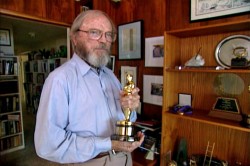 _
_ 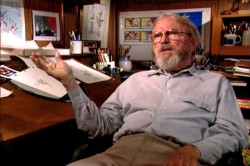
- Tonight on Turner Classic Movies there’s going to be a Chuck Jones jamboree. This is all occasioned by the screening of Peggy Stern & John Canemaker’s fine film,
Chuck Jones: Memories of Childhood at 8:00pm/10:30pm/2:30am EST.
Along with this film a number of Jones’ works will air:
Sniffles and the Bookworm____Elmer’s Candid Camera
Scent-imental Over____You Haredevil Hare
Duck Amuck____One Froggy Evening
What’s Opera Doc____The Dot and the Line
The Bear That Wasn’t
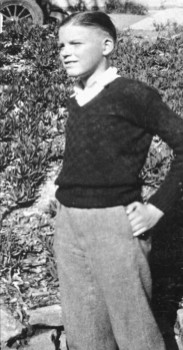 These shorts will be followed by two features on the late night schedule. (Go here to see a full schedule.)
These shorts will be followed by two features on the late night schedule. (Go here to see a full schedule.)
The Phantom Tollbooth was the less-than-stellar feature Chuck Jones co directed with Abe Levitow and Dave Monahan.
1001 Arabian Nights with Mr. Magoo follows that. I’m not sure why since I don’t remember Jones having any involvement on this film. Nevertheless, I’ll be glad to see it again.
The Stern/Canemaker film is a delicate piece that quite nicely gives Jones the opportunity of relaying many of his memories from his pre-animation days. You get to see what a wonderful draftsman Jones was as he quickly draws from memory on-camera. There’s one quick portrait he does of his uncle that impressed me very much.
John Canemaker has done a lot of good animation here which illustrates well some of the pieces Jones is remembering. The animation nominally attempts Jones’ style, but John’s own style is so pervasive that the animation comes off as much his. I guess this is probably appropriate for such an independent film. Audiences who aren’t sophisticated about animation wouldn’t notice a difference. Why should they?
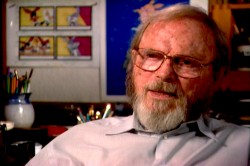 Much has been made about the “abuse” Chuck Jones’ father layed on the son. This amounts to strong beatings. I suspect that this treatment was typical of most families in the 19-teens. “Spare the rod and spoil the child.” One wonders how this may have affected Jones’ art.
Much has been made about the “abuse” Chuck Jones’ father layed on the son. This amounts to strong beatings. I suspect that this treatment was typical of most families in the 19-teens. “Spare the rod and spoil the child.” One wonders how this may have affected Jones’ art.
Thank heaven for our more “enlightened age.”
The film moves quickly and informs quite gently. It deserves the attention TCM is giving it, and it also deserves the attention of the animation community, as it properly will receive.
Here’s the four star review in today’s NYDaily News.
Here’s The Boston Globe review.
And here’s The Cleveland Plain Dealer.
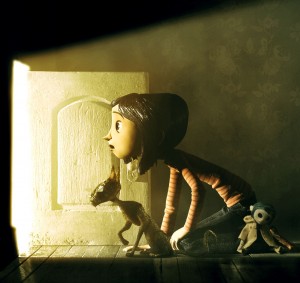 - I finally got to see Coraline over the weekend and have to complete some thoughts I gave prior to actually seeing the film. This is the first of the recent 3D films that I’ve seen in 3D. The effect worked well but, to me, was a complete hind-rance to the filmgoing experience.
- I finally got to see Coraline over the weekend and have to complete some thoughts I gave prior to actually seeing the film. This is the first of the recent 3D films that I’ve seen in 3D. The effect worked well but, to me, was a complete hind-rance to the filmgoing experience.
When we filmed Raggedy Ann, there was a significant problem with cel flare because of the black backgrounds during the Greedy sequence. It was troubling. I’d recommended using polarized filters. This meant that the lights had to be filtered, and a second filter had to be placed on the lens to offset the lighting. The positive was that the flares were resolved. The negative was that there was a graying of all colors. On film, especially in animation, this problem can be rectified in the timing of the final print at the lab.
With Coraline we’re wearing, essentially, the same polarized filters to interpret the 3D effect. We don’t have built-in laboratories to adjust the colors in our head. We’re viewing grayed-down colors, and I was totally annoyed by it. By lifting the glasses, the screen would often look normal in 2D. But the colors were excellent. This aspect of the design was completely lost in the polarized flters over our eyes.
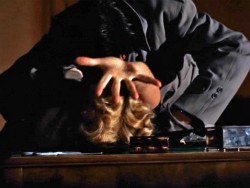 The 3D effects weren’t principal or necessary to the whole, and the film would have been just as good in 2D. However, in 3D I was never able to enter the screen. The glasses were in the way and annoyed me. My eyes watered up often during the film, and I spent a lot of time wiping away tears. This is not the best way to watch a film.
The 3D effects weren’t principal or necessary to the whole, and the film would have been just as good in 2D. However, in 3D I was never able to enter the screen. The glasses were in the way and annoyed me. My eyes watered up often during the film, and I spent a lot of time wiping away tears. This is not the best way to watch a film.
But then, I once saw Hitchcock’s Dial M For Murder in 3D. It’s rarely projected that way, so it was fun to see how the master would
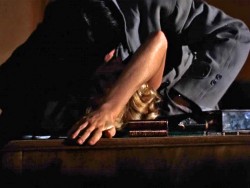 handle the effect. He used it to create a wall between us and the characters. The bar in the apartment, flowers, other furniture often stood between us and the characters in marked 3 dimensional separation.
handle the effect. He used it to create a wall between us and the characters. The bar in the apartment, flowers, other furniture often stood between us and the characters in marked 3 dimensional separation.
Only once did he bring us into the film via 3D. A murderer has Grace Kelly bent back over a desk. We’re watching from the back side of the desk as he strangles her. She reaches out of the screen searching for a pair of scissors to defend herself. However, the effect was
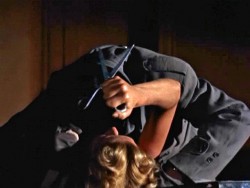 that the hand coming out into the theater seems to be imploring the helpless audience to get up and save her. It was frustrating and exhausting and completely involved us, the audience.
that the hand coming out into the theater seems to be imploring the helpless audience to get up and save her. It was frustrating and exhausting and completely involved us, the audience.
She eventually grabs the scissors and kills the guy. However, despite the red/green glasses we were totally drawn in. Much was added as part of the film’s effect. I’ve seen the film numerous times in 2D and always remember the scene in 3D when I’ve seen it again.
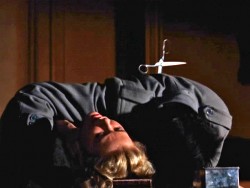
No such scene exists in Coraline nor is there any necessity to see it in 3D. I liked how Henry Selig created 3 dimensional differences between her real home and the “other” home. However, this is too subtle to be a necessity. Consequently, to me the 3D was little more than a gimmick.
The film, itself, seemed quite impressive technically, but I’m not sure the story was well told. I’d have to read the book, but I saw a lot of interesting fairy tale elements that were set up and violated before the film was over. I’m not sure that’s a product of the original.
The story wants to talk about mothers and their black/white role in our lives, yet it ultimately doesn’t work with the telling.
The story goes in and out of dreams, and for much of the film could have been a dream, yet the end gives us no opportunity to interpret the film for ourselves that way. Let’s just say I was disappointed on many levels despite the technical agility on display.
Regardless of all my negative comments, this is an important animated film to see. It will probably be one of, if not THE best of this coming year. See it if you’re at all involved in animation.
Monsters vs Aliens is about to open and a long trailer ran in 3D before Coraline. Obviously, the 3D effect is more dramatic in that film. However, on the basis of the trailer alone, it felt even more of a gimmick in that movie. I have to say that there’s nothing there for me in the new Dreamworks product, and I’ll save a viewing for Oscar time when I won’t have to pay an additional $5 to have my eyes water and be annoyed.
(By the way the great Hitchcock stills come from a brilliant website:
1000 Frames of Hitchcock.
___________Mark Mayerson originally led me to this invaluable site.)

on 24 Mar 2009 at 11:49 am 1.Larry Levine said …
Chuck Jones has been a life-long hero & his work continues to be a daily inspiration. Needless to say, I’ve had today circled on my calender for months.
on 24 Mar 2009 at 2:58 pm 2.Mark Mayerson said …
After seeing Coraline, I read Neil Gaiman’s original. I was surprised to see that many of the problems with the film’s story originated in the source material. This also made me think again about Beowulf, which Gaiman co-wrote the screenplay for. Plotting does not seem to be his strongest suit.
on 26 Mar 2009 at 4:03 pm 3.George Griffin said …
About “Dial M,” the 3D effect was used at one other crucial point, when a key is held in an open hand and thrust toward the audience. This important clue (I’ve forgotten the particulars) becomes, just like the hand and scissors, an electrifying moment in the narrative due the film’s conservative use of 3D.
About “Coraline,” I totally agree with you about the color and brightness. I never adjusted to it and continually looked over the glasses for the real color which of course was a crazy double. The 3D doesn’t serve to differentiate the different parents or different psychological zones, i.e. it seems to be used indiscriminately. The buttons-for-eyes business isn’t so disturbing considering the artificial design throughout. What really matters is the enormous gulf between the child and her two sets of parents: the real ones are controlling and indifferent, the false ones are deceptively permissive and avidly attentive. The disturbance this can set up for a child has enormous dramatic potential which I didn’t see or feel in “Coraline.”
on 23 May 2012 at 1:57 pm 4.James Buccelli said …
I really enjoyed reading this article. I’m actually committing Sin #2 ‘Waiting too long to comment’! However, I felt compelled to express appreciation, since I think many of these you enumerate are unconscious mistakes that can easily be rectified.